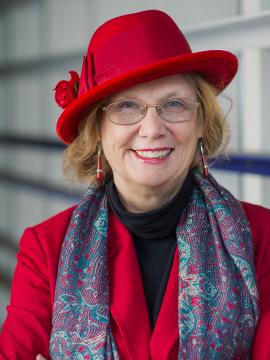

“If you’re going to do something for the rest of your life, do something that you really enjoy.”
That’s the type of advice that can get lost when students start planning for their future. But that’s exactly how Professor Arlene Sindelar decided she would pursue history—though her path wasn’t exactly straightforward.
Professor Sindelar, who has taught in UBC’s history department and medieval studies program since 2002, actually started in mathematics.
As an undergraduate at Concordia University Chicago, she studied math. She even taught math as a student teacher before graduating. But it was while student teaching that she made an interesting observation—she enjoyed studying math, she liked teaching math, but she didn’t really think much about math once she left the classroom.
Her “History”
Instead, she thought about history. History had always captured her imagination and it was history that drew her back. “From very early on, I read biographies about historical people and I read novels set in historical times,” she recounts. This early primer proved to be an important foundation down the line. “Most of my framework for remembering the chronology of early modern France comes from a whole series of French novels—romance novels actually,” she laughs.
But what started as a fascination with stories turned into something much more. Professor Sindelar decided to go to grad school to study the very same stories she used to read—or at least the history behind the paperback romance and melodrama.And you can tell how much she still loves history today by the excitement in her voice.“You see, history isn’t about necessarily finding all the answers, it’s about knowing what questions to ask—because that changes everything. That’s why history is continually revised—because we’re thinking of new questions.”
This continual reshaping of the past makes it an exciting time for medieval studies. This is a time, she says, when academics are asking questions that go beyond the battlefield or the king’s court, beyond a knight and his horse or a king and his sceptre. “[In the Middle Ages] ninety percent of the people were peasants. There were women. There were children who never lived to adulthood. They were all part of history—nobody used to question about that!”
Her Teaching
But these are the kinds of questions that Professor Sindelar does ask in her classroom. She teaches medieval legal and social history as well as courses in the history of women and the family during the Middle Ages. In her classes, students get a chance to look at age-old topics in brand-new ways. And when class sizes are small enough and students can really engage in the material, that’s when she gets most excited—when she can see the cogs turning. “You enjoy teaching most when you can really see into [students’] minds and provide them with the support they need to learn to do what they’re doing better and to think through what they’re learning.”
For all her work inside the classroom, Professor Sindelar is just as committed to students outside of the classroom. Being as involved as she is—teaching, researching, advising, and mentoring—Professor Sindelar doesn’t have a whole lot of spare time. Her reason for juggling so many roles is simple: “When you have somebody with a problem, you don’t want not to solve it. You want to figure out what to do to help them.”
Of course, navigating the academic waters has never been easy. But Professor Sindelar believes that the challenges are even greater for students today. With rising tuition, mounting debt, shifting job markets and a whole host of other obstacles, students can use all the help they can get.
Her Advice
So how do they get through it all?
Sometimes, it’s best to begin at the beginning. Professor Sindelar gives students the one piece of advice she has never stopped following: “Study what you love and do it well.”


